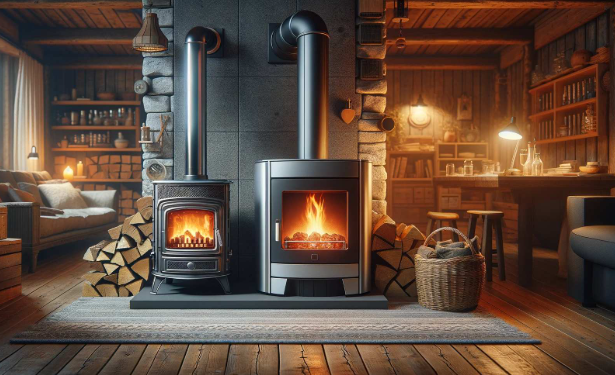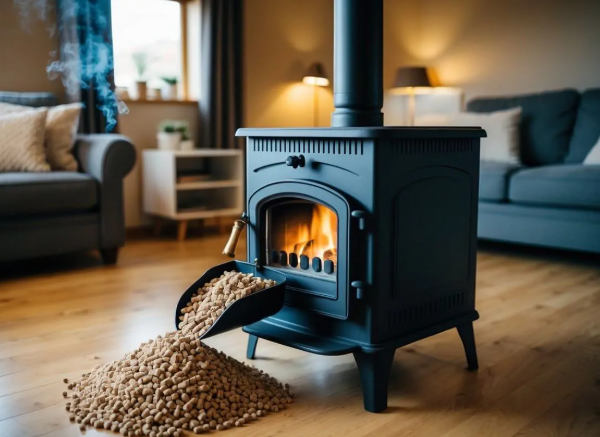
So you’ve done the research and decided. You’re saying to yourself, “A pellet stove or pellet stove insert is what I want!” Great choice! Pellet stoves are efficient, eco-friendly, and can make any space feel cozier. But now comes the tricky part: Which one is right for you? With so many options on the market, it’s easy to feel overwhelmed. Don’t worry—we’re here to help.
By the time you’re done reading, you’ll have all the tips you need to pick the perfect pellet stove for your home.
How Do Pellet Stoves Work?
Let’s start with the basics. Pellet stoves use small, compressed wood or biomass pellets as fuel. These pellets are loaded into a hopper, which feeds them into a combustion chamber. Once ignited, the pellets burn to produce heat. This heat is then distributed into the room via a fan system.
It’s not just about heating—it’s about efficient heating. The design allows for consistent heat with minimal waste. And unlike traditional wood stoves, pellet stoves don’t require constant tending. Just load up the hopper, set your desired temperature, and let the stove do the work.
Benefits of Using a Pellet Stove
Pellet stoves aren’t just another way to heat your home. They come with a host of benefits that make them a smart choice for modern households. Whether you're looking to reduce your heating costs or minimize your environmental impact, a pellet stove might be just what you need.
Energy Efficiency
Pellet stoves are all about doing more with less. Unlike traditional wood stoves that lose a significant amount of heat through the chimney, pellet stoves are engineered to maximize energy use. They burn fuel cleanly, converting up to 90% of the energy in pellets into heat for your home. This high efficiency doesn’t just save energy—it saves money. Plus, the automated systems ensure a steady burn, so you’re not wasting pellets unnecessarily.
Eco-Friendly Heating
If you’re concerned about the planet, a pellet stove is a step in the right direction. These stoves emit far fewer greenhouse gases compared to oil or gas heating systems. The pellets themselves are often made from recycled wood waste, such as sawdust or agricultural residues, which means you’re using a renewable resource. And because the combustion process is so efficient, there’s less ash and particulate matter released into the air.
Cost Savings
Heating your home can be expensive, especially during harsh winters. Pellet stoves offer a cost-effective alternative to oil, propane, or electric heating systems. The pellets themselves are relatively affordable and widely available. Many homeowners find that switching to a pellet stove significantly reduces their heating bills. And let’s not forget the long-term savings from the stove’s efficiency—less wasted heat means less money burned.
Low Maintenance
Compared to traditional wood stoves or fireplaces, pellet stoves are remarkably low-maintenance. Their advanced design produces minimal ash, meaning you won’t have to clean them out as often. Some models even come with self-cleaning systems that handle the ash and residue for you. Routine maintenance is typically limited to occasional vacuuming of the ash pan and checking the hopper. It’s heating made easy.
Consistent Heating
Ever sat near a wood stove and felt like you were on fire, only to freeze a few minutes later? Pellet stoves eliminate this problem by providing steady, even heat. With features like built-in thermostats and automated feeding systems, you can set your desired temperature and let the stove do its thing. No more fiddling with logs or adjusting dampers—it’s consistent warmth, hassle-free.
10 Helpful Tips for Choosing the Best Pellet Stove
Selecting the right pellet stove can feel like a big decision. After all, this isn’t just another appliance—it’s an investment in your home’s comfort and efficiency. Here’s a detailed breakdown of what you should consider.
Determine Your Heating Needs
Think about the size of the area you want to heat. A small pellet stove might work for a single room or a cozy cabin. For larger homes, you’ll need a stove with higher heat output, measured in BTUs (British Thermal Units). As a general rule, a stove rated at 20,000 to 40,000 BTUs can comfortably heat a space of 800 to 2,000 square feet. Don’t overdo it, though—oversized stoves can lead to overheating and wasted fuel.
Understand Pellet Stove Types
Not all pellet stoves are the same. Freestanding stoves are versatile and can be placed anywhere with proper ventilation, making them ideal for open spaces. On the other hand, pellet stove inserts are designed to fit into existing fireplaces, turning an inefficient wood-burning setup into a high-performance heater. Consider your home’s layout and your specific needs before making a choice.
Evaluate Pellet Stove Efficiency
Efficiency isn’t just about saving money—it’s about getting the most out of every pellet. Look for stoves with high efficiency ratings (80% or more) and certifications from organizations like the EPA. These stoves burn cleaner and release fewer emissions. The result? Lower fuel costs and a smaller environmental footprint.
Calculate Long-Term Operating Costs
It’s easy to focus on the sticker price, but don’t forget to factor in ongoing costs. These include the price of pellets, electricity to power the stove’s fan and auger, and regular maintenance. For example, larger hoppers can hold more pellets, reducing how often you need to refill, which might save you time and effort in the long run.
Look at Design and Aesthetics
Your pellet stove will be a focal point in your home, so style matters. Do you prefer sleek, modern designs or something more traditional? Many models come in a variety of finishes, like matte black, stainless steel, or enameled colors, allowing you to match your home’s decor. Don’t underestimate the value of choosing a stove that looks as good as it performs.
Examine Installation Requirements
Installation can make or break your pellet stove experience. These stoves require proper ventilation, typically through a chimney or vent pipe. Some models can vent horizontally, which might simplify installation. Be sure to account for required clearances from walls and furniture, as well as any local building codes. A professional installer can help ensure everything is set up safely and efficiently.
Check Hopper Capacity
The hopper is the storage bin for your pellets. A larger hopper means the stove can run longer without needing a refill. For example, a stove with a 40-pound hopper might run for 24 hours, depending on the heat setting. If you don’t want to be constantly adding pellets, look for a model with a larger capacity.
Compare Heat Output (BTUs)
BTUs determine how much heat the stove can produce. But bigger isn’t always better. A stove with too many BTUs might overheat a small room, while one with too few won’t adequately warm a large space. Use your home’s square footage as a guide when comparing models. A well-matched BTU rating ensures both comfort and efficiency.
Review Smart Features and Technology
Today’s pellet stoves come packed with features designed for convenience. Think programmable thermostats, automatic ignition systems, and even Wi-Fi connectivity. Some models allow you to control settings from your phone or integrate with smart home systems. While these features might increase the upfront cost, they add convenience and can improve your overall experience.
Research Brand Reputation and Warranty
Not all brands are created equal. Do some homework before making a purchase. Read reviews from other homeowners, ask for recommendations, and check out expert opinions. Also, pay attention to the warranty. A good warranty can protect you from unexpected repair costs and is often a sign of a manufacturer that stands behind its product.
Making the Right Choice

Choosing the perfect pellet stove doesn’t have to be complicated. Start by understanding your needs—both in terms of heating and design. Think about efficiency, cost, and maintenance. And don’t forget to consider where and how you’ll install it.
The good news? There’s a pellet stove out there for every home, style, and budget. With the right research and these tips in hand, you’ll soon be enjoying a warm, cozy space powered by a stove that works perfectly for you.











(0) comments
We welcome your comments
Log In
Post a comment as Guest
Keep it Clean. Please avoid obscene, vulgar, lewd, racist or sexually-oriented language.
PLEASE TURN OFF YOUR CAPS LOCK.
Don't Threaten. Threats of harming another person will not be tolerated.
Be Truthful. Don't knowingly lie about anyone or anything.
Be Nice. No racism, sexism or any sort of -ism that is degrading to another person.
Be Proactive. Use the 'Report' link on each comment to let us know of abusive posts.
Share with Us. We'd love to hear eyewitness accounts, the history behind an article.